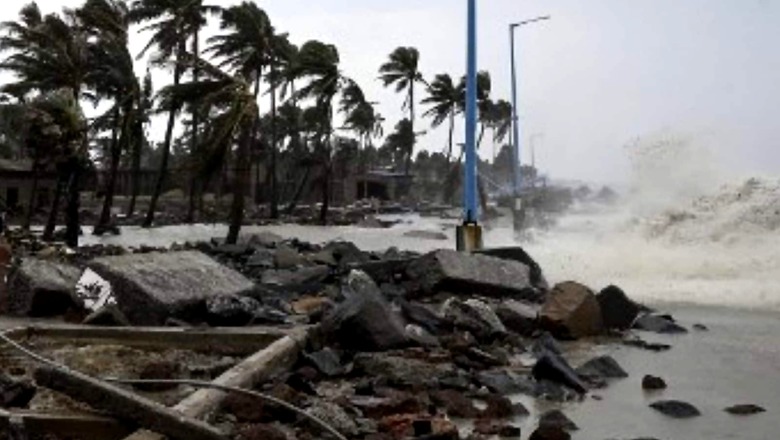
views
Cyclone Asani, a name suggested by Sri Lanka, is set to intensify in the Bay of Bengal on March 21 with wind speeds of 70-80 kmph gusting to 90 kmph and hit Andaman and Nicobar, further moving towards Bangladesh and Myanmar. It is going to be this year’s first cyclonic storm.
The India Meteorological Department (IMD) on Thursday explained that low-pressure area (LPA) over central parts of south Bay of Bengal become a well-marked low-pressure area (WML) on Saturday along and off Andaman and Nicobar islands before intensifying into a depression by March 20 and into a cyclonic storm on the next day.
“Thereafter, it will move north-northeastwards and reach near Bangladesh and adjoining north Myanmar coast by the morning of March 23,” the weather office said.
LPA over central parts of south Bay of Bengal become WML on 19th along & off A&N Islands, intensify into a depression by morning of 20th March and into a cyclonic storm on 21st March. To move nearly north-northeastwards and reach near Bangladesh-north Myanmar coasts on 22nd March pic.twitter.com/Iq4CVcwn44— India Meteorological Department (@Indiametdept) March 17, 2022
WHAT IMD Says
Sea condition is very likely to become rough over the southeast Bay of Bengal and adjoining south Andaman Sea on Thursday and Friday.
The IMD has advised fishermen not to venture into central parts of the South Bay of Bengal and adjoining Equatorial Indian Ocean on Wednesday and into southeast Bay of Bengal and Andaman Sea area on Thursday and Friday. It has also advised fishermen not to venture into Andaman Sea and along and off Andaman and Nicobar Islands during between Saturday and Tuesday.
Andaman and Nicobar Islands are expected to experience squally winds on Sunday which were likely to intensify to gale winds with speeds reaching 70-80 km per hour, gusting to 90 kmph the next day.
MHA Guidelines Issued
The Ministry of External Affairs (MHA) has reviewed preparedness of central ministries or agencies and administration of Andaman and Nicobar in the view of impending cyclone in Bay of Bengal. The ministry also said that teams of NDRF, Indian Army, Navy and Air Force have been asked to be on alert for any untoward situation.
Fishing, tourism & shipping activities stopped. Fishermen advised to return from sea. @adgpi, @indiannavy, @IAF_MCC, @IndiaCoastGuard on stand by. Central Ministries ready with assistance if required. (4/5)— Spokesperson, Ministry of Home Affairs (@PIBHomeAffairs) March 17, 2022
Union Home Secretary Ajay Kumar Bhalla has also directed central ministries and agencies to keep a regular watch and be in touch with Andaman and Nicobar administration for help.
HOW CYCLONES FORM?
Usually, April and May represent a time of peak cyclonic activity in the Indian Ocean, months which coincide with the hot Indian summer. And heat has a lot to do with how these tropical cyclones arise.
Tropical cyclones form only over warm ocean waters near the equator. The way it works is this: warm, moist air over the ocean rises upwards from the surface, leading to a vacuum-like situation that causes a low air pressure area to form below.
When that happens, cooler air from the surrounding area rushes in to replace the warm air that is rising. But this new, cooler air, too, becomes heated and rises. This cycle of hot air rising up and being replaced by the cooler air leads to the formation of a cloud system over the area, which spins and grows as it is fed by the ocean’s heat and water evaporating from its surface.
This system now has all the makings of a storm system and, as it rotates faster and faster, an eye forms at its centre. The eye — very calm and and with very low air pressure — as you may know, is one of the key characteristics of a tropical cyclone.
So, when does a storm become a cyclone: The textbook definition is that when winds in this rotating mass of clouds reach speeds of 63 kmph, the storm is called a ‘tropical storm’. At 119 kmph, the storm is classified as a ‘tropical cyclone’.
Cyclones are divided into categories depending on the strength of the winds it unleashes. The Saffir-Simpson scale is a five-tier table that maps severity from 1-5. The idea behind thus classifying cyclones is to tie it up with the potential impact it has and the damage it can cause through flooding after making landfall.
HOW DO CYCLONES MOVE AND HOW DO THEY MAKE LANDFALL?
The will-it-won’t-it uncertainty about where exactly a cyclone is to make landfall is largely due to the fact that although they are brought into being by a vacuum, cyclones do not exactly move in one. That is, cyclones are very much influenced by their interaction with the land and surrounding air masses, which is what is mainly responsible for changes in their route and intensity as they move from sea to land.
Experts say that even “small changes in the initial environment surrounding a cyclone could make large differences in its eventual path, making it harder to predict its movement because it is difficult to work out exactly what the conditions are at sea”.
Smaller cyclones can be controlled by lower to mid-levels of the atmosphere, but well-developed cyclones are influenced by large-scale air masses, which is what can cause them to take an erratic path. Experts add that since “cyclones are rotating storms on a rotating planet”, they tend to move towards the poles and to the west.
WHO KEEPS THE NAMES OF CYCLONES?
According to the World Meteorological Organisation (WMO), names are necessary for tropical cyclones because there can be more than one such system operating in a particular zone. The names, it adds, are set according to the rules at regional level. In the Atlantic and in the Southern hemisphere (Indian ocean and South Pacific), tropical cyclones names are given in alphabetical order, and women and men’s names are alternated.
Generally, the name list is proposed by the National Meteorological and Hydrological Services (NMHS) of the WMO members of a specific region and approved by the respective tropical cyclone regional bodies at their annual or biennial sessions.
Worldwide there are six regional specialized meteorological centres (RSMCs) mandated for issuing advisories and naming tropical cyclones. The Indian Meteorological Department is one of the six RSMCs mandated to provide tropical cyclone advisories to 13 member countries, including Bangladesh, India, Iran, Maldives, Myanmar, Oman, Pakistan, Qatar, Saudi Arabia, Sri Lanka, Thailand, UAE, and Yemen.
RSMC, New Delhi, is also mandated to name the tropical cyclones developing over the north Indian Ocean, including the Bay of Bengal and the Arabian Sea.
Read all the Latest News India and Breaking News here
















Comments
0 comment